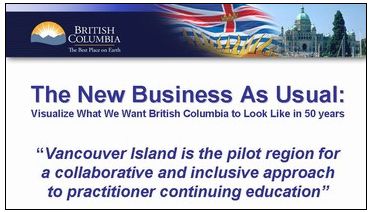Changing the Way British Columbians Do Business Around Water: What is the Elephant in the Living Room?
Cowichan Valley earning Lunch Seminar Series
The Learning Lunch Seminar Series is a precedent-setting approach to continuing education for local government practitioners; and is the first step in building a regional team approach so that there will be a common understanding and consistent messaging on Vancouver Island regarding on-the-ground expectations for rainwater management and green infrastructure.
The pilot Cowichan Valley Learning Lunch Seminar Series comprised a set of three sessions held during the June-July 2008 period.
To Learn More:
For links to each seminar in the series, visit the homepage on the Vancouver Island community-of-interest.
Living Water Smart
Released by Environment Minister Barry Penner on June 3rd 2008, Living Water Smart will change the way British Columbians do business around water. Of relevance to the curriculum for the Learning Lunch Seminar Series, Living Water Smart provides the over-arching policy framework for Beyond the Guidebook: The New Business As Usual.
Kate Miller used the analogy of the ‘elephant in the living room’ to illustrate why and how the Cowichan Valley Regional District and CIty of Courtenay have seized the opportunity to show provincial leadership in co-sponsoring the Learning Lunch Seminar Series.
Elephant in the Living Room
The ‘elephant in the living room’ was created by Banksy, the famed British graffiti artist. The elephant has been made to stand in a makeshift living room, to blend in to its surroundings. Banksy is thought to be making a point about poverty and other important issues which he believes are ignored despite their enormous impact on so many lives.
In elaborating on the story behind the image, Kate Miller told the Learning Lunch audience that “there is an elephant in our room right now…which is around how do we deal with rainwater management…how do we deal with the larger policy issues…what’s the objective.”



